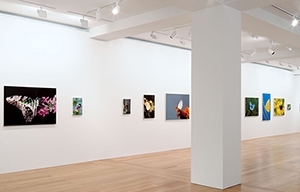- Singing Palette > Art Blog > Singing Palette's Blog > How to survive for traditional art galleries in today's e-business?
- How to survive for traditional art galleries in today's e-business?
- Singing Palette2016-07-12 20:21
- View Artworks by Singing Palette >>

- The best way for traditional art galleries to survive is by staying relevant. Whether that means bumping up the advertising or taking examples from the section titled most well-known art galleries, staying ahead of the market and its trends are a great way to separate yourself from an e-business and all of its advantages.
- Understand That Traditional Art Galleries are still RelevantThere is nothing quite like meeting in person the artist who nearly brought you to tears with his or her work. Or how about finding a collector with a gallery that closely matches your own art tastes? These are both selling points for traditional art galleries that want to survive in a marketplace where the e-business has become king. The experience is something that can’t be mimicked on any other platform, and it is what makes art galleries such a wonderful place to see it all in one spot.Let’s also not forget that even in today’s tech driven world there are still people without internet access. Although that number shrinks every day, many people still find themselves in art galleries out of necessity more than choice. While purchasing art online may be more ideal for the community, viewing art is still something that is very much done in person. People shouldn’t be surprised when a person makes it a point to view art in person and then turns around and purchases it online. This is a common practice, and one of the many important attributes of a brick and mortar art gallery.Tips to Separate You from the other Art GalleriesSometimes being different can make all the difference in the world. This is true with all of the competition, and gains more traction when you consider the amount of work it takes to keep a traditional art gallery in business. So what are some good ideas to make an art gallery stand out from the rest?Not all art galleries are customer centric, meaning that they don’t cater to the random onlooker. Not everyone that walks through the doors of a local art gallery is going to be an expert, or even intermediate user. Taking steps to make sure that customers of all levels are welcome will go a long way in making your business stand out from the rest of the pack. This positive reinforcement will lead to word of mouth, and even more customers in the long run.Another important tip that is often overlooked is to understand that expert collectors are not your only customers. Many art galleries and their artists put a lot of effort into attracting these types of customers, and in turn ignore first time buyers or intermediate users. This goes back to the first point of making sure all customers are welcome in the art gallery. But in terms of this tip, local art galleries should split their focus on growing their own collectors rather than catering to serious collectors. This creates opportunities to not only expand the community from within, but to improve relations and networking on the outside of the establishment. Remember that expert collectors at one point in their lives were also first time buyers.The last tip is one that can be risky if mismanaged, but if done right will be a huge boost to your earnings and profile. Consider test driving the idea of an optional membership system that costs a small amount yearly and gives customers priority access to items that are closed off to normal customers. This includes unreleased art from in-house painters, special engagement pieces with artists or curators and even private bidding on items that have not yet hit auction. The parameters of the membership are completely under your control, and it’s completely optional for the customers with nothing to lose on your end.Push Your AuctionsWhether private or public, auctions at art galleries are one of the biggest draws in the media due to the often incredible pieces up for sale. Many of the originals that get sold will probably never be seen by the public again, so it makes attending an art gallery auction a one of a kind experience. Anyone in the community that has never been to one are doing themselves a disservice by not going, and should immediately look up an art gallery that has an upcoming auction in their area. Despite what many people think, all of the art doesn’t sell for the outrageous millions that people read about in the news. There are many affordable pieces that sell for no more than a trip to the grocery store, but people won’t know that fact unless you make it a point to let them know.Support the Community with NetworkingSome of the best recommendations for paintings comes from meeting a dealer or a fellow collector at the many events held in art galleries. Often outsiders that have no interest in art will get invites from friends to these events and find that they’re very much interested in the market. There really is no better place to exchange ideas with fellow artists than at a gallery event, and besides the discovery of new and fresh paintings there are a lot of things for beginners to learn about. A beginner in the world of art as a student or collector will often find that their tastes change and mature depending on how often they attend these events. There is no shortage of art galleries to begin learning from, and because of that there will always be interesting people to meet and mingle with. Word of mouth through passive networking at an art gallery has led many to discover art websites, and to broaden their art instincts.In order for a traditional art gallery to survive in a tech driven world, they have to make it a point to be relevant. Staying relevant is the key, and involving your community and keeping those doors revolving will keep you afloat.
- Copyright Statement: members bear all the responsibilities for what you're posted.
All the reproduction of any forms about this work unauthorized by Singing Palette or the blogger including images, texts and so on will be deemed to be violating the Copyright Laws.
To cite this webpage, please link back here.
- Latest Blog Posts
- Thinking about Art Auctions in the 21st Century
2016-10-16 19:56 - Comment on Works
2016-07-02 11:08 - “Man and Sword Becomes One” in Art
2016-05-30 15:25 - Klimt's Painting and the Film by Same Name: Woman in Gold
2016-06-18 16:46 - There is nothing quite as inspiring as the bold serenity of the mountain art
2016-05-13 17:43 - Dali: the only difference between me and a madman is that I am not mad
2016-05-13 17:37 - Rococo art is an 18th-century artistic movement
2016-05-13 17:34 - Definition of African Art
2016-05-13 17:32
>> Comments >> Report







 Singing Palette
Singing Palette